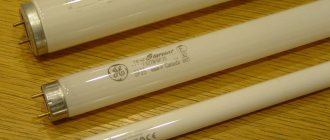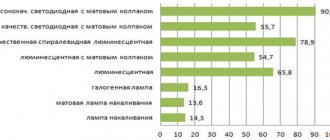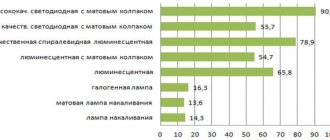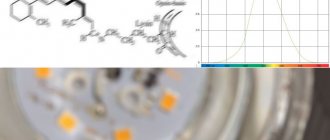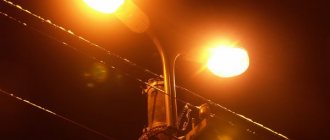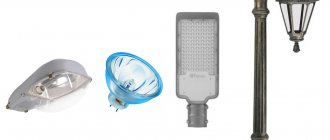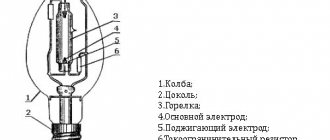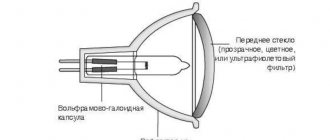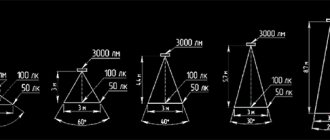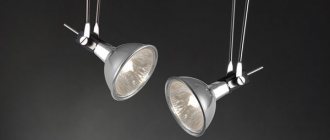Fluorescent lamps come in a variety of modifications with unique parameters and technical characteristics. In order for the consumer to be able to navigate all these products, special markings for fluorescent lamps have been developed, allowing them to make the right choice for specific operating conditions.
Despite the variety of models, all products of this type are represented by two large groups. These are linear lamps that require special luminaires, and compact light sources used in conjunction with standard sockets.
How does a fluorescent lamp work?
The principle of operation of a fluorescent lamp must be known at least in general terms, since the most important parameters and characteristics are reflected in the labeling of a particular product.
A standard fluorescent lamp cannot work on its own. A special lamp is required to turn on and start. When assembled, both elements form a single whole. The main part is a lamp made in the form of a glass cylindrical tube. Initially, a vacuum is created in it, after which the internal space is filled with a mixture of mercury vapor and a certain inert gas. The gaseous state of mercury is maintained by excess pressure inside the flask.
Electrodes are installed at the ends of the lamp, to which electric current is supplied through the terminals. A tungsten helix is stretched between them, coated with barium, cesium and other metals capable of emitting free electrons in large quantities. Interacting with mercury vapor, they form radiation in the ultraviolet spectrum, invisible to the human eye. When it hits glass walls coated with phosphor, ultraviolet light is converted into visible light, which illuminates the surrounding space.
At the initial stage, external voltage cannot independently create a full-fledged electron flow. Therefore, the electromagnetic throttle and starter are included in the overall operation. As a result, conditions are created under the influence of which the current strength increases and a glowing gas discharge is formed.
Philips colors
Equipment of this brand also enjoys well-deserved popularity among domestic consumers. Philips fluorescent lamps are labeled as standard. The color rendition of this equipment can be indicated by numbers from 4 to 9. The temperature of lamps of this brand is encrypted by numbers from 27 to 65. Also, the marking of Philips models may contain their series (for example, TL-D).
In addition to the usual ones, this manufacturer also produces luminescent equipment intended for installation in aquariums - TLD AQUARELLE. Such lamps differ from standard ones in that they emit light with a high density in the blue spectrum. This shade not only emphasizes the beauty of the underwater world, but also contributes to:
- creating optimal conditions for photosynthesis;
- stimulating the formation of oxygen in water, which is very beneficial for fish.
The diameter of the bulbs of these lamps can be 16 mm or 28 mm (T5, T9). Also in the TLD AQUARELLE marking there are codes G5 and G13, which characterize the parameters of the bases. The power of these lamps can be 8-58 W.
Main types, types and modifications
Compared to other light sources, fluorescent lamps are represented by a wide range of models, with various shapes, sizes, individual parameters and technical characteristics.
First of all, fluorescent lamps are classified according to high and low pressure. The first option is used for lighting industrial facilities and public places where high quality color rendering is not required. The second type of lamps, low pressure, is used mainly in everyday life. Such products are also known as energy-saving.
The form of fluorescent lamps is divided into two main types:
- Linear. Most of them are made in the form of straight tubes of various lengths and diameters. The most exotic products resemble the letter U or are made in the shape of a ring.
- Compact. They are distinguished by curved flasks, the shape of which significantly expands the scope of use. The sockets can be pin or threaded for standard sockets.
Voltage
Most fluorescent lamps produced by modern industry are designed for use in a standard household electrical network. That is, most often such equipment operates at a voltage of 220 V.
However, fluorescent lamps of 127 and 75 V are also available for sale today. The first type of such equipment, designed for reduced voltage, is used in the subway. 75 V lamps are usually installed in electric trains.
The markings indicate the voltage required for such equipment directly. That is, exactly 220 V, 127 V or 75 V.
Parameters and technical specifications
The main parameters and characteristics of fluorescent lamps determine their performance and possibility of use in certain areas.
Among the parameters, the most important ones are:
- Light indicators. They are characterized by luminous flux and its pulsation, brightness, color and spectral composition of radiation.
- Electrical indicators. First of all, the parameters of power and operating voltage, the characteristics of the mains current, the type of discharge and the luminous area used in the lamp are taken into account.
- Operational indicators. They include service life, luminous efficiency, shapes and sizes, the relationship of light and electricity parameters with supply voltage and external operating conditions.
One of the main parameters by which fluorescent lamps are divided is the combustion voltage, which depends on the discharge occurring inside the bulb.
In this regard, all products can be divided into the following types:
- With arc discharge and combustion voltage up to 220 volts. This type is most common not only in our country, but also abroad. Ignition is carried out using a preheated oxide cathode, on which the entire design of the product depends.
- With arc discharge and combustion voltage up to 750 volts. Lamps of this type are used abroad. They do not require preheating of the cathodes, and their power is 60 watts.
- With glow discharge and cold cathodes. They are mainly used in advertising and signal lighting. The work uses low currents - 20-200 milliamps. They are installed in installations operating with high voltage and work as light sensors that monitor certain parameters. The small diameter of the tubes allows you to give the products almost any shape.
Tips for choosing
When choosing fluorescent lighting sources, the following recommendations must be taken into account:
- The most profitable , from an economic point of view, are class A lighting fixtures, which have an efficiency ratio of 1:6 with incandescent lamps and are characterized by savings of up to 80% of electricity.
- To illuminate streets, bridges and other objects , it is possible to use 2-in-1 lamps that have 2 modes: normal operation and a mode with an energy consumption of less than 1 W, using sensors to switch to another mode under changing external conditions.
- the buyer needs to evaluate energy savings, power consumption and its service life.
- It is necessary to focus on the base of the lighting source and its dimensions and their compliance with the operating conditions of the buyer.
- When choosing a lamp, you need to pay attention to its color rendition and the temperature it reaches, since insufficient lighting in the room may result in a blue tint of the spectrum, which is unpleasant for family members.
- Do not buy lighting sources of this design for conditions with frequent switching on and off of the lighting device.
Chroma and Emissivity
Important indicators taken into account in the labeling of products are their color and emission. The creation of radiation in fluorescent lamps occurs using a phosphor, which converts ultraviolet rays into visible light. The efficiency of such a transformation depends not only on the phosphor itself, but also on the physical properties of the applied layer of this substance.
Typically, the coating is applied to the entire inner surface of the flask. Initially, the excitation of the glow also occurs inside, and the resulting light goes outside. Simultaneously with the light flux, the mercury discharge emits visible lines that are clearly visible through the phosphor layer. As a result, there is a dependence of the luminous flux not only on the absorption coefficient of the phosphor, but also on its reflection coefficient.
The color of the emitted light does not always exactly match the color of the phosphor applied to the glass. The flux emitted by the mercury discharge creates a certain shift in the color of the lamp into the spectral region of blue. This shift is very insignificant and does not have any noticeable effect on the color index of fluorescent lamps.
Fluorescent lamps used in general-purpose lighting systems, despite the many shades, can be grouped into the following groups:
- LD (daylight) lamps with a color temperature of 6500 K.
- LCB (cold white light) – color temperature 4800 K.
- LB (white light) – color temperature 4200 K.
- LTB (warm white light) – color temperature 2800 K.
What can be the power
This parameter is indicated in the marking by the letter W and the numbers following it. Knowing the power of a fluorescent lamp, you can determine how large a room it can illuminate. For example, this indicator can be coded as 11 W, 15 W, 20 W.
With regard to power, the designations in the marking of fluorescent lamps correspond to certain codes of the same equipment with an incandescent filament. These ratios are indicated in special tables. The data presented in them can greatly facilitate the buyer’s choice. For example, the designation 11 W will correspond to an incandescent lamp power of 55 W, 15 W - 75 W, 20 W - 100 W.
Classification and marking of lamps
The marking is applied to the flask itself and metal parts. The ability to decipher the symbols greatly facilitates the selection of the desired light source.
Letter designations correspond to the following indicators:
- L – means fluorescent lamp;
- B – white light;
- D – daylight;
- U is a universal option.
For example, LB corresponds to a white light fluorescent lamp.
Marking the diameter and shape of the flask
The diameter of a glass bulb is designated in inch units in accordance with international standards. The unit of measurement is considered to be 1/8 of it. The size itself is designated by the letter T, and in full it looks like T8, which corresponds to 26 mm, since 8/8 of an inch is one or one whole inch (25.4 mm), which will be almost equal to 26 mm.
T5 tubes
In the 1990s, longer T5 tubes were developed in Europe (they came to North America in the 2000s), in addition to the shorter ones (mentioned above) already in use around the world. Like European modular furniture, display cases, grid ceiling tiles, etc. for which they were designed, they are based on multiples of 300 mm (11.8 in) "metric feet" instead of 12 in (305 mm) imperial feet, but all they are 37 mm (1.5 in) shorter to allow room for cartridges in the 300 mm modular blocks, as well as for much easier insertion and removal of the joker lights in the reticle.
| Tube diameter 5⁄8 inch (15.875 mm) | Length | Rated power (W) | Notes | |
| High efficiency | High performance | |||
| T5 | 563 mm (22.2 in) | 14 | 24 | Fits in a 0.6 m modular block |
| T5 | 863 mm (34.0 in) | 21 | 39 | Fits in a 0.9 m modular block |
| T5 | 1163 mm (45.8 in) | 28 | 54 | Fits in a modular block 1.2 m long |
| T5 | 1463 mm (57.6 in) | 35 | 80, 49 | Fits in a modular block 1.5 m long |
The diameter of T5 is almost 40% smaller than T8 lamps and almost 60% smaller than T12 lamps. T5 tubes have a G5 base (two-pin 5mm pitch), even for high output tubes (HO and VHO).[8]
Network connection
The simplest connection diagram for fluorescent lamps is based on a starter, inductance (ballast) and a capacitor. The lamps themselves do not provide for their direct connection to an electrical circuit, since when turned off, fluorescent devices have a high resistance, which can only be overcome by a high voltage pulse.
It is also possible to connect two lamps in series, with 2 starters and a starter, but it must be designed for the total power of the lamps. The diagram of a two-lamp lamp is presented below. There is no capacitor in the circuit, but it can also be installed at the input to the device.
The starter (ballast) is included in the electrical circuit as an additional resistor that protects against short circuits. The starter allows you to charge the starter at times of increased lamp resistance, while simultaneously heating the lamp coils.
A fluorescent lamp cannot be started without an accelerator. The total power consumption of all devices connected together with the fluorescent light source to the electrical circuit depends on how the connection circuit is arranged.
Electromagnetic inductance (EMPRA)
A constant inductive inductance connected only to a circuit with an LL of a certain power. When turned on, the resistance of the electronic ballast included in the circuit begins to play the role of limiting the current supply to the lamp.
The EMPRA design is simple and inexpensive to manufacture; therefore, lamps with electromagnetic ballast are cheaper. Despite its low cost and simplicity, it has a number of disadvantages:
- startup duration up to 3 seconds (time depends on lamp wear);
- high starter energy consumption;
- flickering with double the network frequency (100 or 120 Hz) when turned on, which has a detrimental effect on vision;
- short circuit resulting in the inductance electrodes being welded to the device, after which it cannot be removed.
- gradual increase in throttle frequency due to wear;
- weight and dimensions of luminescent devices (compared to analogues of electronic ballasts);
- probable malfunction of the electrical circuit with the throttle mechanism at temperatures below zero Celsius;
The connection diagram for gas-discharge fluorescent lamps with EMF provides for the presence of a starter that regulates the ignition of the LL. However, it consumes additional electricity.
Electronic starter
Electronic ballast (EPG) powers the lamps with a high-frequency power source of 25-133 kHz. When the LDS is turned on with an electronic starter, a person observes a bright flickering for a short time. With the help of electronic ballast, two operating principles for turning on lamps are implemented.
Cold start
Starts the device immediately, but causes significant damage to the electrodes. Lamps with this trigger option are designed to be turned on/off during the day at a low frequency.
Warm start
Before turning on the lamp, the electrodes heat up for 1 second, then it works. There is also a thermal indicator to protect the device from overheating.
LLs based on electronic ballasts are cheaper than they have gained significant popularity, which cannot be said about analogues of electronic ballasts.
Principle of operation
The operating principle of such a device is as follows:
- At the beginning, both electrodes included in the design are in the open position.
- When connected to the mains, a glow discharge occurs inside the device, the strength of which varies between 20 and 50 mA.
- The resulting discharge acts on the bimetallic electrode and causes its gradual heating.
- The heated material causes the actuator electrode to bend. Because of this, the glow discharge disappears, which then helps to close the circuit.
- The current begins to move in a closed circuit, which helps heat the inductor and cathodes of the fluorescent lamp.
- Due to the disappearance of the glow discharge, the bimetallic electrode begins to gradually cool after a certain period of time. As a result of these changes, the electrodes move apart, which leads to an open circuit.
- This action helps generate a fast high voltage pulse that acts on the inductor.
- The choke has a high degree of inductance, so this process contributes to the ignition of the lamp.
- The illumination of the lamp gradually increases, and it begins to consume more voltage from the power source.
- The starter is connected in parallel with the lamp, so the starter begins to lack energy and therefore can generate a new glow discharge. Therefore, the electrodes then remain open.
You may be interested in this Rules for the placement of lamps on a suspended ceiling
Operating principle of LDS
